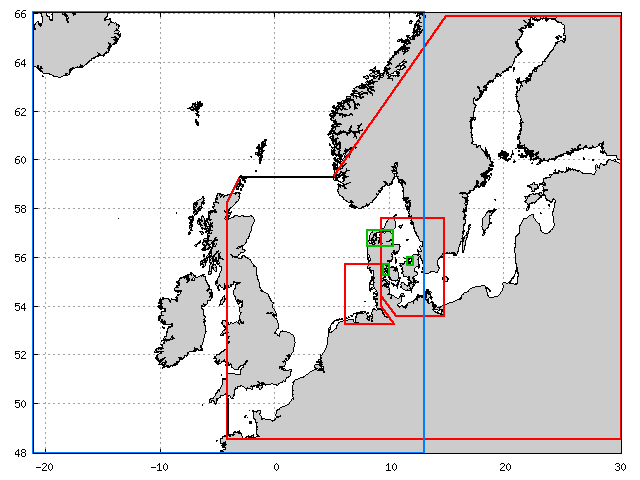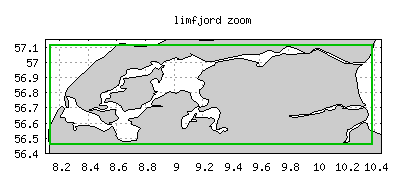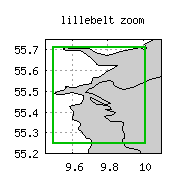
DMI operates a regional 3D ocean model HBM for the North Sea - Baltic,
in order to provide information about the physical state of the Danish and nearby waters in the near future.
The Figure to the right shows model domain and water depth for the 3D grid.
Calculations are carried out at a number of fixed depths, from surface to sea bed.
Sea ice is described by extent,m concentration and thickness. A marine ecology module may be coupled.
Model code
The HBM code was developed in the early 1990'ies
at
Bundesamt für
Seeschifffahrt und Hydrographie (BSH) in Hamburg, Germany. At the time the model was known as BSHcmod.
It has undergone extensive revision in the DMI implementation, in co-operation between DMI and BSH.
Basically the same code is used in the Baltic HIROMB co-operation.
Input
Three types of input is applied: surface fields, point sources, and open boundary conditions.
Heat flux through the sea bed is parameterized.
HBM is forced by DMI's numerical weather prediction (nwp) model
Harmonie. Any nwp model capable of providing the same parametre may in priciple be used.
The following parameters are used:
- 10 metre wind speed and direction
- mean sea level atmospheric pressure
- surface (2 metre) air temperature
- surface air (2 metre) humidity
- cloud cover
HBM calculates surface energy fluxes (mechanical, radiative, thermodynamic) using
bulk parameterisation formulae. NWP fluxes are thus not used, even if provided, but recalculated ny HBM.
Point source data are
- freshwater fluxes from 846 rivers and diffusive coastal sources
- nutrient from the same rivers (optional)
Open boundary data are:
- tidal sea surface elevation
- monthly climatological hydrography
Data-assimilation
HBM optionally assimilates one or more types of observered or modelled data:
- sea surface temperature from satellite
- vertical profiles of hydrography
- daily open boundary hydrography data
This facility has not been put in operational use as of yet.
Schedule
HBM runs every 6 hours, i.e. 4x/day. A run produces a 5 day forecast
of the 3-dimensionelle state of the ocean.
Output
HBM calculates, at 15 min.intervals
- sea level
- water temperature
- salinity
- ocean currents
- ice thickness and concentration
Temperature, salt and current is calculated
for the entire water column, top to bottom, at ~ 50 fixed depth levels. Sea level at selected, coastal points is calculated in 10 minute time resolution.
Output in high time resolution is intended for internal use. For external use, hourly data is provided.
Output parameter table.
Model set-up
The HBM model set-up consists of 7 model domains:
- NOAMOD - 2-dimensional mesocale model, that calculates sea level as a function of
wind speed and air pressure. Generates boundary data (external surge)
for the regional 3-dimensionan model
- North Sea - Baltic Sea - 3-dimensional regional model with subdomains
- Transition Area - high resolution model of the waters south of Skagen and west of Bornholm
- Wadden Sea - high resolution model of the German Bight
- Roskilde/Isefjord - high resolution fjord model (nested since 2019)
- Limfjord - high resolution fjord model (nested since 2021)
- Lillebælt - high resolution Little Belt model (nested since 2021)




| Model |
NOAMOD |
HBM
North Sea - Baltic Sea |
HBM
Transition Area |
HBM
Wadden Sea |
HBM
Roskilde/Isefjord |
HBM
Limfjord |
HBM
Lillebælt |
| Spatial resolution |
6' lat 10' lon
(6 n.m.) |
3' lat 5' lon
(3 n.m.) |
30" lat 50" lon
(0.5 n.m.) |
1' lat 1'24" lon
(1 n.m.) |
10" lat 10" lon
(0.15 n.m.) |
6" lat 10" lon
(0.1 n.m.) |
10" lat 10" lon
(0.2 n.m.) |
| Vertical layers |
1 |
50 |
52 |
24 |
10 |
21 |
42 |
| Max. top layers thickness |
900m |
8m |
2m |
8m |
2m |
2m |
2m |
Time step:
Barotropic
Baroclinic:
Ice |
15s
-
- |
20s
90s
900s |
10s
90s
900s |
20s
90s
900s |
5s
15s
900s |
2.5s
20s
900s |
5s
20s
900s |
| Atm. forcing |
ECMWF GLM |
Harmonie NEA
ECMWF GLM |
Harmonie NEA
ECMWF GLM |
Harmonie NEA
ECMWF GLM |
Harmonie NEA
ECMWF GLM |
Harmonie NEA
ECMWF GLM |
Harmonie NEA
ECMWF GLM |
| Area: longitude |
21W-13E |
4.1W-30.3E |
9.3E-14.8E |
6.2E-10.5E |
11.6E-12.1E |
8.2E-10.3E |
9.5E-10.1E |
| Area: latitude |
48N-66N |
Baltic Sea: 48.5N-65.9N
North Sea: 48.5N-59N |
53.6N-57.6N |
53.2N-55.7N |
55.6N-56N |
56.5N-57.1N |
55.2N-55.7N |
| Open boundaries |
Radiation condition |
1. Surge contribution from NOAMOD
2. Tidal sea level based on 17 constituents
3. Monthly climatology fields for T and S via a sponge layer
|
nested with regional model |
nested with regional model |
nested with transition area model |
nested with regional and transition area model |
nested with transition area model |
